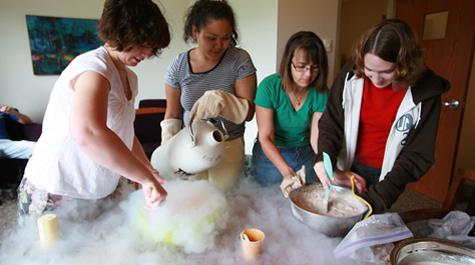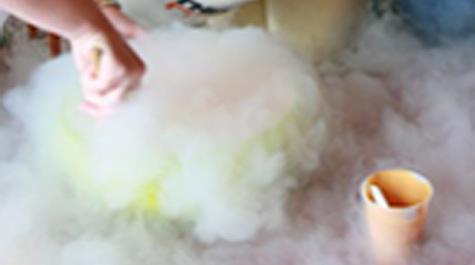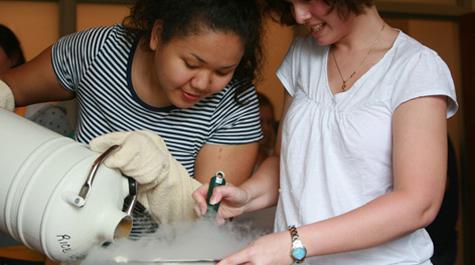Summer treat: Lab-made ice cream
It's a summer chemistry tradition. Once a week, all work stops for ice cream.
This isn't store-bought ice cream. It's not home-made ice cream, either. For years, every summer Wednesday at 3 p.m., students and faculty in the William and Mary Department of Chemistry have gathered together for lab-made ice cream.
The ice cream mix is just like the stuff you'd whip up in the kitchen, but instead of putting it into a ice-packed gizmo, the ice cream is frozen in a matter of seconds by direct application of liquid nitrogen.
The tradition began years ago in Rogers Hall and is being continued in the chemistry department's sparkling new facilities on two floors of the Integrated Science Center. A research group headed by Department Chair Gary Rice came up with the idea. He and his students discussed the possibilities, looked on line for some ice cream recipes and gave birth to a tradition.
"More and more people got involved," Rice said. "So the next year each lab took a week. Every year it gets better and better." He said the early days were guided by an experimental ethos that, while congruent with the highest traditions of scientific inquiry, didn't necessarily turn out good ice cream. He particularly mentioned a rutabaga sorbet and some disappointing efforts involving crushed Captain Crunch. His favorite flavor over the years? Chocolate mint, made with crumbled mint Oreos.
On one recent Wednesday, the group from Associate Professor Lisa Landino's lab had ice cream duty. Shortly before 3, the scene in ISC room 2067 resembled the opening of Shakespeare's MacBeth, with three female members of the William and Mary class of 2009 taking the place of witches and big bowls of milky liquid standing in for cauldrons. Carolyn Edson stirs a bowl of what will shortly become cinnamon-flavored ice cream while Shannon Kim cuts and crumbles pieces of shortcake into a mix already laced with bobbing strawberry hunks. Carolyn Brown presides over a bowl of chocolate-peanut butter.
Landino arrives, grabbing a dewar the size of a diaper pail and taking Kim down the hall to fill it with liquid nitrogen. Dewars are essentially lab-grade thermos bottles and come in a variety of sizes. Landino and Kim set their little dewar next to one as big as a person. The two chemists share a pair of insulated gauntlets, because the liquid nitrogen whistling from large dewar into small is well below -300 degrees Fahrenheit.
One of the side benefits of lab-made ice cream is that the process allows younger students to become comfortable handling cryogenic materials. Liquid nitrogen is an everyday staple in labs, used for a vast range of non-dairy applications such as cooling chemical samples and maintaining powerful high-tech analysis instruments at optimum operating temperatures. Nitrogen in itself is not scary stuff—it's the major component of air—but in liquid form it can give you frostbite pretty quickly.
Back in room 2067, the dewar is uncorked and the liquid nitrogen poured directly into the strawberry shortcake mix. The nitrogen immediately begins to boil, absorbing heat from the dairy-based mix, which solidifies as it freezes. This is a time for collaborative lab technique: One person pours, slowly; a second stirs, rapidly. Thick, cold vapor spills over the bowl's rim and rolls across the table, a vivid demonstration of the Liedenfrost effect. The MacBeth resemblance is renewed.
Making ice cream with liquid nitrogen calls for a lot of stirring, keeping the frozen bits circulating. Landino takes a turn with the spoon, stirring the chocolate peanut butter mix and calling for another shot of liquid nitrogen. Each summer around 50 to 55 students, graduate and undergrad, are working in chemistry. Add in faculty, staff and visitors and three big bowls of ice cream can disappear almost as quickly as boiling nitrogen vapor.
"We're all part of one big chemistry family," Landino says to the swelling group of faculty and students who are watching her nudge an errant bit back into the smoking bowl. "So it doesn't matter if I get my fingers in it."
The eating and socializing part of the break is over almost as quickly as the ice cream is made and everyone goes back to their labs, a few licking their spoons. These are busy chemists, so there's no time to wait for ice cream to harden, or to linger over a cup of delicious lab-made strawberry shortcake.


















